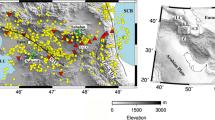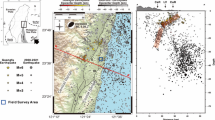Abstract
We performed a tectonophysical analysis of earthquake frequency–size relationship types for large Central Asian earthquakes in the regions of dynamical influence due to major earthquake-generating faults based on data for the last 100 years. We identified four types of frequency–size curves, depending on the presence/absence of characteristic earthquakes and the presence or absence of a downward bend in the tail of the curve. This classification by the shape of the tail in frequency–size relationships correlates well with the values of the maximum observed magnitude. Thus, faults of the first type (there are characteristic earthquakes, but no downward bend) with Mmax ≥ 8.0 are classified as posing the highest seismic hazard; faults with characteristic earthquakes and a bend, and with Mmax = 7.5–7.9, are treated as rather hazardous; faults of the third type with Mmax = 7.1–7.5 are treated as posing potential hazard; and lastly, faults with a bend, without characteristic earthquakes, and with a typical magnitude Mmax ≤ 7.0, are classified as involving little hazard. The tail types in frequency–size curves are interpreted using the model of a nonlinear multiplicative cascade. The model can be used to treat different tail types as corresponding to the occurrence/nonoccurrence of nonlinear positive and negative feedback in earthquake rupture zones, with this feedback being responsible for the occurrence of earthquakes with different magnitudes. This interpretation and clustering of earthquake-generating faults by the behavior the tail of the relevant frequency–size plot shows raises the question about the physical mechanisms that underlie this behavior. We think that the occurrence of great earthquakes is related to a decrease in effective strength (viscosity) in the interblock space of faults at a scale appropriate to the rupture zone size.
Similar content being viewed by others
References
Allen, C.R., Active Faulting in Northern Turkey, Div. Geol. Sci., Californ. Inst. Tech., 1969, pp. 32–34.
Burtman, V.S., The Late Cenozoic geodynamics of Tibet, Tarima, and Tien Shan, Geotektonika, 2012, no. 3, pp. 18–46.
Davison, Jr. F.C. and Scholz, C.H., Frequency-moment distribution of earthquakes in the Aleutian arc: a test of the characteristic earthquake model, Bulletin of the Seismological Society of America, 1985, vol. 75, no. 5, pp. 1349–1361.
Dobrovol’skii, I.P., Teoriya podgotovki tektonicheskogo zemletryaseniya (A Theory of Precursory Processes Prior to Tectonic Earthquakes), Moscow: IFZ AN SSSR, 1991.
Dobrovol’skii, I.P., Matematicheskaya teoriya podgotovki i prognoza tektonicheskogo zemletryaseniya (A Mathematical Theory of the Precursory Period and Prediction of Tectonic Earthquakes), Moscow: Fizmatlit, 2009.
Gan Weijun and Xiao Genru, Present-day crustal motion GPS velocity field of central Asia, in Atlas of Seismotectonics in Central Asia, Beijing, 2013, pp. 41–42.
Gao Xianglin, Plate dynamics context of seismotectonics in central Asia, in Atlas of Seismotectonics in Central Asia, Beijing, 2013, pp. 29–31.
Gatinskii, Yu.G., Vladova, G.L., Prokhorova, T.V., and Rundkvist, D.V., The geodynamics of Central Asia and the prediction of catastrophic earthquakes, Prostranstvo i Vremya, 2011, vol. 3, no. 5, pp. 124–134.
Gorbunova, E.A. and Sherman, S.I., The probability of large (M ≥ 7.5) earthquakes in the fault zones of Central Asia: A tectonophysical analysis, Geodinamika i Tektonofizika, 2016, vol. 7, no. 2, pp. 303–314.
Gutenberg, B. and Richter, C.F., Frequency of earthquakes in California, Bull. Seismol. Soc. Am., 1944, vol. 34, pp. 185–188.
Kagan, Y.Y., Observational evidence for earthquakes as a nonlinear dynamic process, Physica D: Nonlinear Phenomena, 1994, vol. 77, no. 1, pp. 160–192.
Kasahara, K., Earthquake Mechanics, Cambridge University Press, 1981.
Kissin, I.G., Trigger processes: Methodological aspects, participation of fluids, in Triggernye effekty v geosistemakh (Trigger Effects in Geosystems), Moscow: GEOS, 2013, pp. 146–152.
Kocharyan, G.G., Geomekhanika razlomov (Geomechanics of Faults), Moscow: GEOS, 2016.
Kocharyan, G.G., Another word on possible prevention of earthquakes, in Triggernye effekty v geosistemakh (Trigger Effects in Geosystems), Proc. Third All-Russia seminar conference, IDG RAN, Moscow: GEOS, 2015, pp. 30–39.
Kocharyan, G.G. and Spivak, A.A., Dinamika deformirovaniya blochnykh massivov gornykh porod (The Dynamics of Deformation in Blocky Rock Massifs), Moscow: IKTs Akademkniga, 2003.
Kostrov, B.V., Mekhanika ochaga tektonicheskogo zemletryaseniya (The Mechanics of the Rupture Zone of a Tectonic Earthquake), Moscow: Nauka, 1975.
Koulakov, I., High-frequency P and S velocity anomalies in the upper mantle beneath Asia from inversion of worldwide travel time data, Journal of Geophysical Research, 2011, vol. 116, no. B4, B04301.
Laherrere, J. and Sornette, D., Stretched exponential distributions in nature and economy: “fat-tails” with characteristic scales, The European Physical Journal B-Condensed Matter and Complex Systems, 1998, vol. 2, no. 4, pp. 525–539.
Latousakis, J. and Drakopoulos, J.A., Modified formula for frequency-magnitude distribution, PAGEOPH, 1987, vol. 125, no. 5, pp. 753–764.
Levin, B.V. and Sasorova, E.V., Seismichnost’ Tikhookeanskogo regiona. Vyyavlenie global’ nykh zakonomernostei (Seismicity of the Pacific Region. Identification of Global Patterns), Moscow: Yanus-L, 2012.
Lukk, A.A., The seismicity of the Pyandzh River basin and nonlinear shapes of the frequency-size curve, in Eksperimental’naya seismologiya (Experimental Seismology), Moscow: Nauka, 1971, pp. 297–313.
Mogi, K., Pressure dependence of rock strength and transition from brittle fracture to ductile flow, Bull. Earth. Res. Inst., 1966, vol. 44, pp. 215–232.
National Earthquake Information Center (NEIC), 2016. Available from: http://earthquake.usgs.gov
Pacheco, J.F., Scholz, C.H., and Sykes, L.R., Changes in frequency-size relationship from small to large earthquakes, Nature, 1992, vol. 355, pp. 71–73.
Papadopoulos, G.A., Skafida, H.G., and Vassiliou, I.T., Nonlinearity of the magnitude-frequency relation in the Hellenic Arc.Trench System and the characteristic earthquake model, Journal of Geophysical Research, 1993, vol. 98, no. B10, pp. 17 737–17 744.
Pisarenko, V.F. and Rodkin, M.V., Raspredeleniya s tyazhelymi khvostami: prilozheniya k analizu katastrof (Distributions with Heavy Tails: Applications to the Analysis of Catastrophes), Vychislitel’naya Seismologiya, 38, Moscow: GEOS, 2007.
Pisarenko, V. and Rodkin, M., Heavy-Tailed Distributions in Disaster Analysis. Advances in Natural and Technological Hazards Research, vol. 30, Dordrecht, Heidelberg, London, N. Y.: Springer, 2010.
Pisarenko, V. and Rodkin, M., Statistical Analysis of Natural Disasters and Related Losses, Springer Briefs in Earth Sciences, Dordrecht, Heidelberg, London, N. Y.: Springer, 2014.
Purcaru, G., A new magnitude-frequency relation for earthquakes and a classification of relation types, Ceophys. J. R. astr. Soc. 1975, vol. 42, pp. 61–79.
Qinghua Han, Lichen Wang, Jie Xua, Carpinteri, A., and Lacidogna, G., A robust method to estimate the bvalue of the magnitude-frequency distribution of earthquakes, Chaos, Solitons and Fractals, 2015, vol. 81 pp. 103–110.
Rebetskii, Yu.L., Tektonicheskie napryazheniya i prochnost’ prirodnykh massivov (Tectonic Stresses and the Strength of Natural Rock Massifs), Moscow: Akademkniga, 2007.
Riznichenko, Yu.V., Problemy seismologii (Problems in Seismology), Moscow: Nauka, 1985.
Rodkin, M.V., A model of seismicity as a set of avalanchelike relaxation episodes that occur on the set of metastable states, Fizika Zemli, 2011, no. 10, pp. 18–26.
Rodkin, M.V., Pisarenko, V.F., Ngo Thi Ly, and Rukavishnikova, T.A., On possible occurrences of the law governing the distribution of rare great earthquakes, Geodinamika i Tektonofizika, 2014, vol. 5, no. 4, pp. 893–904.
Rodkin, M.V., Ngo Thi Ly, and Labuntsova, L.M., Expanding the multiplicative cascade model to describe the recurrence of great earthquakes in application to the seismicity of Southeast Asia, Geofizicheskie Issledovaniya, 2015, vol. 16, no. 2, pp. 59–69.
Sadovskii, M.A., Bolkhovitinov, L.G., and Pisarenko, V.F., Deformirovanie geofizicheskoi sredy i seismicheskii protsess (Deformation in the Geophysical Medium and the Seismic Process), Moscow: Nauka, 1987.
Schwartz, D.P. and Coppersmith, K.J., Fault behavior and characteristic earthquakes: Examples from the Wasatch and San Andreas fault zones, Journal of Geophysical Research, 1984, vol. 89, no. B7, pp. 5681–5698.
Seminskii, K.Zh., Tectonophysical patterns in lithospheric destruction: The Himalayan compression zone, Tikhookeanskaya Geologiya, 2001, vol. 20, no. 6, pp. 17–30.
Sherman, S.I., Strain waves as a trigger mechanism for seismic activity in seismic zones of continental lithosphere, Geodinamika i Tektonofizika, 2013, vol. 4, no. 2, pp. 83–117.
Sherman, S.I., Seismicheskii protsess i prognoz zemletryasenii: tektonofizicheskaya kontseptsiya (The Seismic Process and Earthquake Prediction: A Tectonophysical Concept), Novosibirsk: Akademicheskoe Izdatel’stvo Geo, 2014.
Sherman, S.I., Genetic sources and tectonophysical regularities of divisibility of the lithosphere into blocks of various ranks at different stages of its formation: tectonophysical analysis, Geodynamics & Tectonophysics, 2015, vol. 6, no. 3, pp. 387–408.
Sherman, S.I., Tectonophysical criteria for the generation of rupture zones of large earthquakes in the seismic zones of Central Asia, Geodinamika i Tektonofizika, 2016, vol. 6, no. 4, pp. 495–512.
Sherman, S.I., Berzhinskii, Yu.A., Pavlenov, V.A., and Aptikaev, F.F., Regional’nye shkaly seismicheskoi intensivnosti. Opyt sozdaniya shkaly dlya Pribaikal’ya (Regional Scales of Seismic Intensity: Developing a Scale for the Baikal Region), Novosibirsk: SO RAN, Filial GEO, 2003.
Sherman, S.I., Bornyakov, S.A., and Buddo, V.Yu., Oblasti dinamicheskogo vliyaniya razlomov (rezul’nany modelirovaniya) (Areas of Dynamic Influence of Faults: Modeling Results), Novosibirsk: Nauka, SO AN SSSR, 1983.
Sherman, S.I., Ma Jin, and Gorbunova, E.A., Recent strong earthquakes and seismotectonics in Central Asia, Geodynamics & Tectonophysics, 2015, vol. 6, no. 4, pp. 409–436.
Shi-Jun Chen, Zhi-Cai Wang, and Jiu-Qing Tao, Nonlinear magnitude frequency relation and two types of seismicity systems, Acta Seismologica Sinica, 1998, vol. 11, no. 2, pp. 207–218.
Sinadinovski, C. and McCue, K.F., Recurrence relationships for Australian earthquakes, AEES 2001 Canberra Conference Proceedings, 2001, Paper 25.
Sobolev, G.A., Osnovy prognoza zemletryasenii (Principles of Earthquake Prediction), Moscow: Nauka, 1993.
Sobolev, G.A., Kontseptsiya predskazuemosti zemletryasenii na osnove dinamiki seismichnosti pri triggernom vozdeistvii (The Concept of Earthquake Predictability Based on the Dynamics of Seismicity Excited by Trigger Action), Moscow: IFZ RAN, 2011.
Sobolev, G.A. and Ponomarev, A.V., Fizika zemletryasenii i predvestniki (Earthquake Physics and Precursors), Moscow: Nauka, 2003.
Stepashko, A.A., Seismodynamics and a deep source responsible for the North China zone of large earthquakes, Geodinamika i Tektonofizika, 2011, vol. 2, no. 4, pp. 341–355.
Stirling, M.W., Wesnousky, S.G., and Shimazaki, K., Fault trace complexity, cumulative slip, and the shape of the magnitude-frequency distribution for strike-slip faults: a global survey, Geophys. J. Int., 1996, vol. 124, pp. 833–868.
Ulomov, V.I. and Shumilina, L.S., Komplekt kart obshchego seismicheskogo raionirovaniya territorii Rossiiskoi Federatsii — OSR-97. Masshtab1: 8000000. Ob”yasnitel’naya zapiska i spisok gorodov i naselennykh punktov, raspolozhennykh v seismoopasnykh raionakh (A Set of General Seismic Zonation Maps for the Area of the Russian Federation (OSR-97). Scale 1: 8000000. An Explanatory Note and a List of Cities and Other Population Centers Situated in Earthquake-Prone Regions), Moscow: OIFZ, 1999.
Vikulin, A.V. and Ivanchin, A.G., On the modern concept of a blocky hierarchical structure of the geologic medium and some of its consequences for geosciences, Fiziko-Tekhnicheskie Problemy Razrabotki Poleznykh Iskopaemykh, 2013, no. 3, pp. 67–84.
Vostrikov, G.A., Svyaz’ parametrov grafika povtoryaemosti, seismicheskogo techeniya i ochaga zemletryaseniya (Relationships between Parameters of the Recurrence Curve, Seismic Flow, and Earthquake Rupture Zones), Trudy GIN RAN, 1994, no. 482.
Wang S. and Zhang, Z., Plastic-flow waves (slow waves) and seismic activity in Central-Eastern Asia, Earthquake Research in China, 2005, vol. 1, pp. 74–85.
Wesnousky, S.G., Scholz, C.H., Shimazaki, K., and Matsuda, T., Integration of geological and seismological data for the analysis of seismic hazard: a case study of Japan, Bulletin of the Seismological Society of America, 1984, vol. 74, no. 2, pp. 687–708.
Zhalkovskii, N.D., Zakon povtoryaemosti zemletryasenii i nekotorye ego sledstviya (The Law of Earthquake Recurrence and Some Consequences from It). Novosibirsk, 1988.
Zhang Jiasheng, Aeromagnetic anomalies in central Asia and their tectonic implication, in Atlas of Seismotectonics in Central Asia, Beijing, 2013, pp. 25–26.
Zhang Peizhen, Deng Qidong, Zhang Guomin, et al., Geology of the fault zones, Science in China, 2003, vol. 46, pp. 13–24.
Author information
Authors and Affiliations
Corresponding author
Additional information
Original Russian Text © S.I. Sherman, M.V. Rodkin, E.A. Gorbunova, 2017, published in Vulkanologiya i Seismologiya, 2017, No. 6, pp. 49–63.
Rights and permissions
About this article
Cite this article
Sherman, S.I., Rodkin, M.V. & Gorbunova, E.A. A Tectonophysical Analysis of Earthquake Frequency—Size Relationship Types for Catastrophic Earthquakes in Central Asia. J. Volcanolog. Seismol. 11, 434–446 (2017). https://doi.org/10.1134/S0742046317060057
Received:
Published:
Issue Date:
DOI: https://doi.org/10.1134/S0742046317060057




